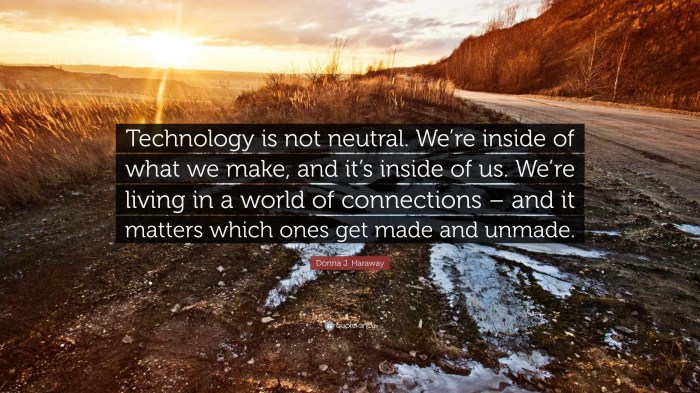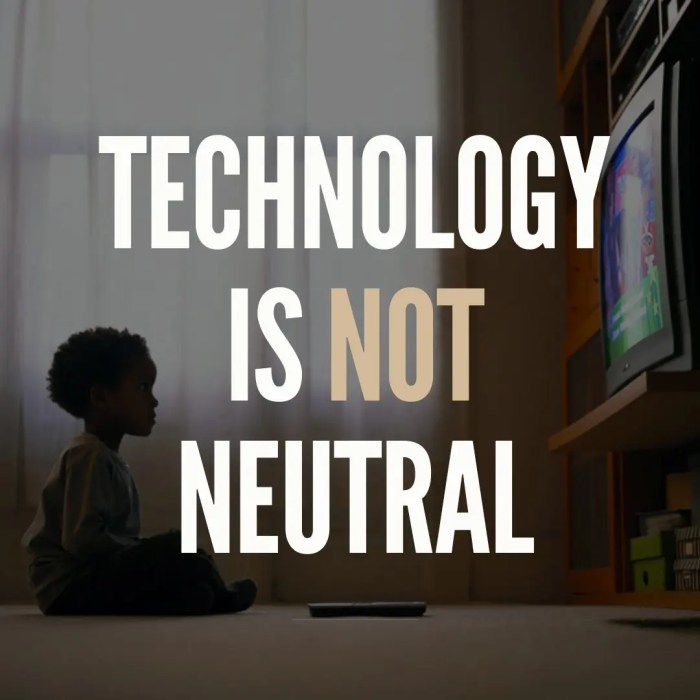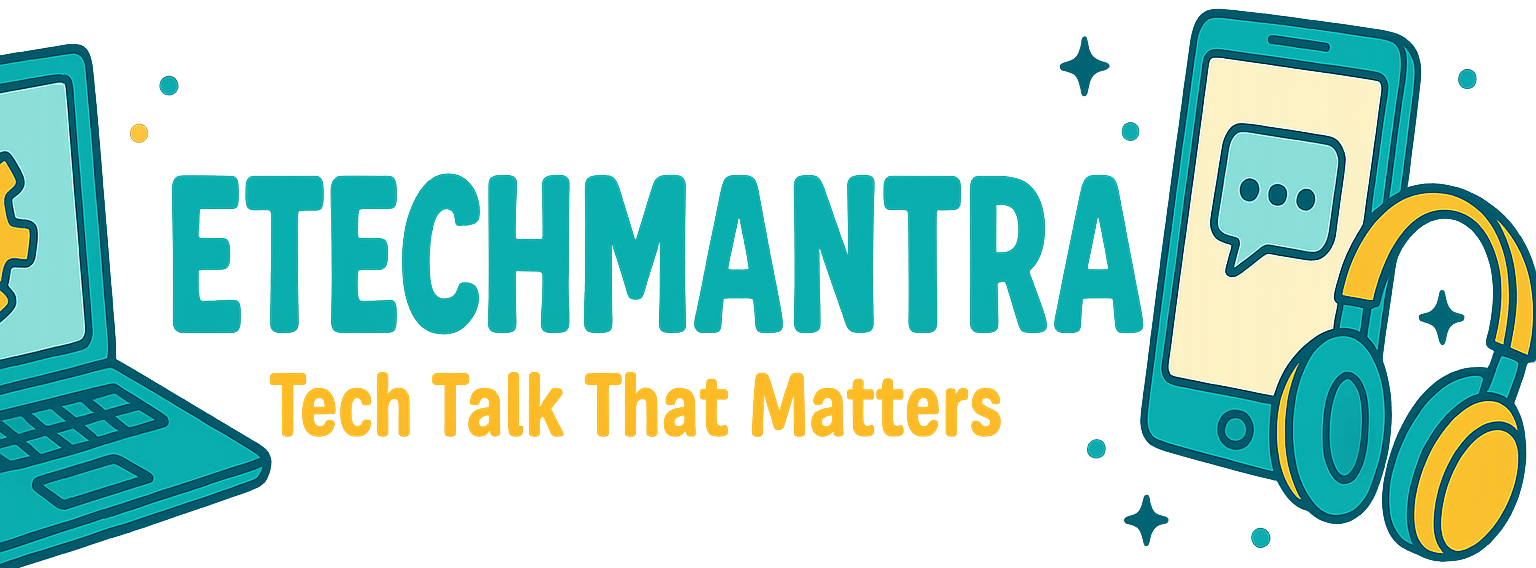Technology Is Never Neutral A Critical Look
Technology is never neutral. From its historical roots to its future implications, technology’s development and application are deeply intertwined with societal values, power dynamics, and often, hidden biases. This exploration delves into the complex relationship between technology and society, examining how technological advancements have shaped, and continue to shape, our world, for better or worse.
We’ll trace the evolution of technology through time, highlighting moments where neutrality was claimed but later challenged. We’ll examine how technology can perpetuate existing inequalities and biases, and explore the economic and political ramifications of different technological advancements. Ultimately, we’ll discuss ethical frameworks and the importance of critical evaluation in shaping a more just and equitable future powered by technology.
Historical Context of Technology

Technology’s evolution is deeply intertwined with human history, constantly shaping and being shaped by societal values and power dynamics. From the earliest tools to the most advanced digital systems, the journey reveals a complex relationship between innovation and its impact. While often presented as neutral, technology frequently reflects and reinforces existing biases, highlighting the crucial need to critically examine its development and application.
This exploration traces the historical development of technology, highlighting instances where neutrality was claimed or challenged.The historical development of technology is a fascinating and often complex journey. Each technological advancement, from the invention of the wheel to the creation of the internet, has been influenced by the prevailing societal values and power structures of its time. Understanding this interplay is essential to appreciating the often-unintended consequences of technological progress.
Timeline of Technological Development and Neutrality
The development of technology is not a linear progression, but rather a series of interconnected events, influenced by social, economic, and political factors. A detailed timeline would reveal the complex interplay between technological advancement and the social context in which it emerged.
- Prehistoric Era (before 3000 BCE): Early tools and technologies, like the hand axe and the bow and arrow, were primarily focused on survival and hunting. Their application was largely determined by the need to adapt to the environment and obtain resources. The concept of neutrality in technology was largely irrelevant at this stage.
- Ancient Civilizations (3000 BCE – 500 CE): The development of agriculture, writing, and complex infrastructure, such as the pyramids and aqueducts, showcased technological advancements driven by societal needs and resource management. While these technologies served practical purposes, their application was often influenced by the power structures of the time. For example, irrigation systems in ancient Mesopotamia reflected the existing social hierarchy and access to resources.
- Medieval Period (500 CE – 1500 CE): Technological advancements, including the printing press and the development of gunpowder, were often associated with religious or political agendas. The printing press, while facilitating the spread of knowledge, was also used to disseminate religious doctrines and political propaganda. The neutrality of technology remained a theoretical concept in this era.
- Industrial Revolution (1760 – 1840): The Industrial Revolution saw significant advancements in machinery and manufacturing, often fueled by a desire for increased productivity and profit. Technologies like the steam engine and the power loom, while promising increased efficiency, also contributed to social and economic inequalities. The development of machinery led to the rise of factories and the displacement of skilled artisans, raising concerns about the social impact of technology.
- 20th Century: The 20th century witnessed an explosion of technological innovation, from the automobile and airplane to the computer and nuclear weapons. These advancements raised profound ethical questions about their potential consequences. The development of nuclear weapons, initially presented as a means of national defense, quickly revealed its potential for global destruction, prompting significant ethical considerations. The computer revolution, while initially touted for its neutrality, has been linked to issues of data privacy, algorithmic bias, and job displacement.
Influence of Societal Values and Power Dynamics
Technology is not created in a vacuum. The values, beliefs, and power structures of a society profoundly influence the development and application of technology. This influence can range from the design choices made to the specific uses the technology is put to. Throughout history, societal needs and values have shaped the development of technology.
- Military Applications: Throughout history, military needs have driven technological advancement. From the development of weaponry to the creation of sophisticated surveillance systems, military applications have often prioritized efficiency and power over ethical considerations. The arms race in the 20th century demonstrates the potential for technological development to be driven by geopolitical competition.
- Economic Interests: Economic factors play a significant role in shaping technological development. The pursuit of profit and economic growth has often been a major motivator for technological innovation. However, this focus can lead to technological advancements that exacerbate existing inequalities or have unintended negative consequences.
- Social Norms: Social norms and cultural values also shape technological development. For example, the design and use of communication technologies have been influenced by cultural norms related to privacy, communication styles, and social interaction. The design and application of technology reflect existing cultural values and power structures.
Examples of Biased Technologies
Certain technologies, initially presented as neutral, have later revealed biases or harmful consequences. These examples highlight the importance of considering the potential societal impacts of technology before its widespread adoption.
- Facial Recognition Technology: While initially presented as a tool for security and identification, facial recognition technology has been criticized for its potential bias in identifying individuals based on race and gender. Studies have shown that these technologies are less accurate in identifying individuals from underrepresented groups.
- Algorithmic Bias in Lending: Algorithms used in lending decisions have been found to discriminate against certain demographics, leading to unequal access to financial resources. These algorithms reflect and perpetuate existing societal biases.
Evolution of Ethical Considerations
The ethical considerations surrounding technology have evolved significantly over time. As technology becomes more complex and pervasive, the ethical challenges it poses become increasingly complex.
- Early Concerns: Early concerns about technology were often focused on its potential impact on human labor and social structures. The Luddites, for example, opposed the introduction of new machinery in the Industrial Revolution, fearing job displacement.
- Modern Concerns: Modern ethical considerations about technology encompass a broader range of issues, including data privacy, algorithmic bias, and the potential for autonomous weapons systems. The development of artificial intelligence raises unique ethical questions about the nature of consciousness and the future of human work.
Perceived Neutrality of Technological Advancements
A comparison of different technological advancements across various eras reveals the changing perception of technological neutrality.
| Era | Technological Advancements | Perceived Neutrality | Actual Impact |
|---|---|---|---|
| Prehistoric Era | Tools, weapons | Neutral (survival-focused) | Influenced hunting, gathering |
| Industrial Revolution | Steam engine, factories | Neutral (efficiency) | Social inequality, environmental damage |
| Information Age | Computers, internet | Neutral (information access) | Digital divide, privacy concerns |
Technological Bias and Inequality
Technology, while offering immense potential for progress, often reflects and exacerbates existing societal biases. The algorithms and data sets used to build technological systems are not neutral; they are shaped by the biases present in the world around them. This inherent bias can lead to unequal outcomes and reinforce existing power structures, potentially harming marginalized groups. Understanding these biases is crucial to harnessing technology’s power for the benefit of all.The creation and implementation of technological systems are often influenced by the values and priorities of those in power.
Data used to train algorithms may reflect historical inequalities, perpetuating and even amplifying those disparities. This can lead to unfair or discriminatory outcomes in areas like loan applications, hiring processes, and even criminal justice. Consequently, it’s vital to critically examine the data and algorithms used to ensure that technology does not exacerbate existing social inequalities.
It’s a common refrain that technology is never neutral, and the recent partnership between Intel and Facebook, where Intel taps Facebook multitudes for massive research efforts, demonstrates this perfectly. This collaboration highlights how the development and application of tech are inherently intertwined with societal values and power structures. Ultimately, the choices we make about technological advancements profoundly shape our world, for better or worse.
Potential Biases in Algorithms and Data Sets
Algorithms, at their core, are sets of rules designed to process information. The data used to train these algorithms often reflects existing societal biases, which can be inadvertently embedded into the algorithms themselves. For example, if a facial recognition system is trained primarily on images of light-skinned individuals, it may perform less accurately on images of people with darker skin tones.
Similarly, if a loan application algorithm is trained on data that shows a higher default rate among certain demographic groups, it may unfairly discriminate against members of those groups. This bias can have a significant impact on individuals and communities.
How Technology Perpetuates Social Inequalities
Technology can inadvertently perpetuate existing social inequalities in several ways. For instance, unequal access to technology itself can create a digital divide, widening the gap between those who have access to the resources and those who do not. Moreover, the very nature of some technologies can disproportionately affect certain groups. For example, the automation of jobs in manufacturing industries may disproportionately affect low-income workers who are often employed in these sectors.
Examples of Disproportionate Impact on Communities
Certain technologies have had a disproportionate impact on specific communities. Consider algorithmic decision-making in the criminal justice system. Biased algorithms may contribute to harsher sentencing for certain groups, leading to overrepresentation in the prison system. Similarly, in the financial sector, discriminatory loan algorithms can hinder access to credit for minority communities, perpetuating cycles of poverty.
Reinforcement of Power Structures Through Technology
Technology can be used to reinforce existing power structures by creating systems that maintain the status quo. For instance, social media platforms can amplify the voices of those already in positions of power, while marginalizing others. This can lead to a concentration of power and influence in the hands of a select few, further exacerbating existing inequalities.
It’s a common misconception that technology is inherently neutral. The truth is, every tech advancement, from social media platforms to sophisticated military equipment, comes with embedded biases and power dynamics. This is especially clear when considering mobilization and the big security opportunity, as explored in more depth here: mobilization and the big security opportunity. Ultimately, the way technology is developed and deployed profoundly shapes our world, making its neutrality a false promise.
Amplification and Mitigation of Social Biases
| Aspect | Amplification | Mitigation |
|---|---|---|
| Data Collection | Collecting data from biased sources, leading to biased algorithms. | Actively seeking diverse and representative data sets, and critically evaluating data sources. |
| Algorithm Design | Algorithms trained on biased data leading to discriminatory outcomes. | Designing algorithms with fairness in mind, using techniques to mitigate bias. |
| Implementation | Implementing technologies in ways that reinforce existing power imbalances. | Implementing technologies in a transparent and accountable manner, with input from diverse stakeholders. |
| Access and Use | Unequal access to technology exacerbating the digital divide. | Promoting equitable access to technology, and developing digital literacy programs. |
Economic and Political Implications: Technology Is Never Neutral

Technology’s impact on economies and politics is profound and multifaceted. It’s not simply about efficiency gains; it’s about reshaping power structures, altering economic landscapes, and fundamentally changing how nations interact. From the rise of e-commerce to the influence of social media on elections, the influence of technology is undeniable and ever-evolving. This section will explore how technology shapes economic systems and power dynamics, examining its impact on various societal groups and its role in the political arena.
Technology’s Influence on Economic Systems
Technological advancements significantly impact economic systems, driving both growth and inequality. Automation, for example, can increase productivity and efficiency, but also displace workers in certain sectors. The introduction of new technologies often leads to shifts in the demand for labor skills, requiring workforce adaptation and potentially creating economic disparities. The digital economy, fueled by the internet and mobile devices, has created new markets and opportunities, but also raised concerns about market concentration and the digital divide.
Economic Impacts on Different Societal Groups
The economic impacts of technology vary considerably across different societal groups. While some groups benefit from new job creation in tech-related industries or increased access to information and services, others face displacement due to automation or limited access to technology. For example, the rise of online retail has benefited consumers with greater choice and lower prices, but it has also impacted brick-and-mortar businesses, leading to job losses and economic hardship in some communities.
Furthermore, the digital divide exacerbates existing inequalities, with those lacking access to technology facing limitations in education, employment, and economic advancement.
Technology’s Role in Shaping Political Landscapes
Technology has become an indispensable tool in the political sphere, profoundly affecting campaigns, communication, and global relations. Social media platforms, for example, have transformed political campaigning, allowing candidates to reach voters directly and bypass traditional media. This direct communication, while potentially democratizing political processes, also raises concerns about the spread of misinformation and the impact of echo chambers on public discourse.
Additionally, technology has facilitated international cooperation and communication, but also created new avenues for conflict and cyber warfare.
Access and Control of Technology and Political Outcomes
Access to and control over technology significantly influences political outcomes. Nations with robust technological infrastructure and advanced digital capabilities often hold greater influence in the global arena. Conversely, countries lacking access to technology or experiencing digital divides may face disadvantages in economic development and political participation. The control of critical technologies, such as artificial intelligence or 5G networks, can give nations strategic advantages and influence over global affairs.
Economic and Political Advantages and Disadvantages of Technological Advancements
| Technological Advancement | Economic Advantages | Economic Disadvantages | Political Advantages | Political Disadvantages |
|---|---|---|---|---|
| Automation | Increased productivity, efficiency | Job displacement, skill mismatch | Enhanced administrative efficiency | Potential for social unrest, increased inequality |
| Internet | Global markets, e-commerce | Market concentration, digital divide | Increased communication, international cooperation | Spread of misinformation, cyber warfare |
| Artificial Intelligence | Automation, data analysis | Job displacement, algorithmic bias | Enhanced security, predictive capabilities | Loss of human control, ethical concerns |
Social and Cultural Impacts
Technology’s pervasive influence extends far beyond its purely functional aspects. It shapes our social interactions, reshapes cultural norms, and profoundly alters how we perceive and engage with the world. This impact is not uniform across all populations, and its effects are often complex and multifaceted, creating both opportunities and challenges.
Technology, in its essence, is never truly neutral. Its design choices, often unseen, shape our lives in profound ways. Take, for example, the StarTechs KVM switch, a desktop space savior that, by consolidating multiple devices into one, dramatically reduces clutter and enhances workflow. Startechs KVM switch is a desktop space savior Ultimately, though, even this seemingly simple solution reflects a broader technological bias towards efficiency and compactness, highlighting the inescapable neutrality of technology.
Technology’s Influence on Social Interactions
Technology has revolutionized how we connect and interact with others. Social media platforms have created unprecedented opportunities for communication and community building, allowing individuals to connect with like-minded people across geographical boundaries. However, this connectivity can also lead to social isolation and a sense of disconnect from the physical world. The constant bombardment of information and the pressure to maintain a curated online persona can also negatively affect mental health.
Furthermore, online interactions can sometimes devolve into cyberbullying and harassment. These issues highlight the complex and nuanced impact of technology on social dynamics.
Impact on Privacy and Surveillance
The increasing reliance on technology has raised serious concerns about privacy and surveillance. Digital footprints are constantly being generated and stored, making individuals more vulnerable to data breaches and unauthorized access. Government surveillance programs and the use of facial recognition technology raise further ethical questions about the extent to which privacy should be sacrificed for security. The constant monitoring and evaluation of user behavior through algorithms can also perpetuate existing biases and inequalities.
This requires a careful balancing act between security and individual rights.
Alteration of Social Structures and Community Dynamics
Technology has profoundly altered social structures and community dynamics. The rise of online communities has fostered new forms of social organization, enabling individuals to connect with others who share similar interests regardless of their geographical location. However, this can also lead to the erosion of traditional community ties and the development of echo chambers, where individuals are primarily exposed to information that reinforces their existing beliefs.
This creates a challenge in maintaining a healthy balance between local and virtual communities.
Influence on Artistic Expression and Creativity
Technology has provided unprecedented opportunities for artistic expression and creativity. Digital tools and platforms have enabled artists to experiment with new forms of expression, reach wider audiences, and develop their creative skills. Software programs like Photoshop and 3D modeling tools have opened up new avenues for visual arts, while digital music production software has empowered musicians to produce and share their work more easily.
However, the ease of access to digital tools can also lead to concerns about the originality and authenticity of creative works. The proliferation of digital content also raises questions about copyright and intellectual property rights.
Comparison of Social and Cultural Impacts of Different Technologies
| Technology | Positive Impacts | Negative Impacts |
|---|---|---|
| Social Media | Enhanced communication, global connections, community building | Social isolation, cyberbullying, echo chambers, mental health concerns |
| Mobile Phones | Improved communication, accessibility, increased efficiency | Distraction, reduced face-to-face interaction, potential for addiction |
| Artificial Intelligence | Automation of tasks, improved decision-making, advancements in various fields | Job displacement, ethical concerns regarding bias, potential misuse |
Ethical Frameworks and Guidelines
Technology’s impact transcends its purely functional aspects, deeply intertwining with societal values and ethical considerations. Navigating this complex landscape requires a robust framework for evaluating technological advancements and ensuring their responsible deployment. This framework should encompass a range of perspectives, acknowledging potential biases and inequalities, and prioritizing the well-being of all stakeholders.The development and deployment of technology are not neutral processes; they are shaped by the values and priorities of those involved.
Ethical frameworks provide a structured approach to understanding and mitigating the potential harms associated with technology while maximizing its benefits. These frameworks are essential for guiding policymakers, developers, and users towards responsible technology use.
Various Ethical Frameworks for Evaluating Technology, Technology is never neutral
Different ethical frameworks offer diverse lenses through which to evaluate the neutrality of technology. Utilitarianism, for example, emphasizes maximizing overall happiness and well-being, considering the potential benefits and harms of a technology for all affected parties. Deontology, conversely, focuses on adhering to moral rules and duties, regardless of the consequences. Virtue ethics prioritizes character traits and the development of moral agents, highlighting the importance of ethical decision-making processes within the technology development lifecycle.
These frameworks, while distinct, can be complementary, offering a multifaceted understanding of technology’s ethical implications.
Role of Policymakers and Stakeholders in Establishing Ethical Guidelines
Policymakers and stakeholders play a critical role in establishing ethical guidelines for technology development. This requires collaboration among diverse groups, including government agencies, industry representatives, civil society organizations, and the public. Active engagement and input from various perspectives are crucial to ensuring that ethical guidelines reflect a broad range of values and concerns. Effective ethical guidelines should consider potential unintended consequences, incorporate ongoing evaluation mechanisms, and facilitate public discourse on emerging technological issues.
Examples of Existing Ethical Guidelines and Regulations
Numerous examples of ethical guidelines and regulations for specific technologies exist. For instance, regulations governing the use of personal data, such as GDPR in Europe, aim to protect individuals’ privacy and control over their information. AI ethics guidelines often emphasize fairness, transparency, and accountability in the development and deployment of AI systems. These guidelines and regulations, while not always comprehensive, provide a starting point for navigating the complex ethical challenges posed by technology.
Potential Conflicts Between Different Ethical Considerations
Ethical considerations in technology are not always harmonious. A focus on efficiency might conflict with concerns for equity, while a desire for innovation could clash with the need for caution and safety. Understanding and acknowledging these potential conflicts is essential for developing comprehensive ethical frameworks. For instance, the pursuit of high performance in autonomous vehicles might conflict with the need to prioritize safety in accident scenarios.
Importance of Diverse Perspectives in Shaping Ethical Frameworks
Diverse perspectives are essential for shaping ethical frameworks for technology. Including the voices of marginalized communities, underrepresented groups, and individuals with differing experiences and values ensures that ethical guidelines reflect the needs and concerns of all stakeholders. This inclusive approach can help identify potential biases in technology and develop solutions that promote fairness and equity. For example, incorporating diverse perspectives in the design of AI systems can help mitigate biases that might lead to discriminatory outcomes.
Future of Technology and Neutrality
The relentless march of technological advancement presents both exhilarating possibilities and profound challenges. As we venture into a future brimming with innovative technologies, the critical question of neutrality—the idea that technology itself is unbiased—must be constantly reevaluated. Will emerging technologies perpetuate existing societal inequalities or offer pathways to a more just and equitable future? The answer depends on our collective choices and actions today.The future of technology is inextricably linked to the values we choose to embed within its development and deployment.
A crucial aspect of this involves proactively considering the potential biases and societal impacts of these technologies. This necessitates a holistic approach, encompassing ethical frameworks, ongoing critical evaluation, and robust public discourse. Ultimately, the goal should be to ensure that technological progress serves humanity as a whole, rather than exacerbating existing divisions.
Potential Future Implications of Technological Advancements on Neutrality
Technological advancements are rapidly altering our social fabric. AI, for instance, can perpetuate biases present in the data it is trained on, leading to discriminatory outcomes in areas like loan applications or criminal justice. Similarly, algorithms used in social media platforms can reinforce existing societal prejudices and echo chambers, potentially limiting exposure to diverse perspectives. This demonstrates how seemingly neutral technologies can inadvertently amplify existing societal biases, leading to unequal outcomes.
Societal Impacts of Emerging Technologies
Emerging technologies, such as personalized medicine or advanced robotics, have the potential to revolutionize healthcare and manufacturing. However, equitable access to these technologies is crucial. Unequal access can exacerbate existing health disparities or create a new class divide in the workforce. Careful consideration of affordability and accessibility is vital to ensure that these advancements benefit all members of society, not just the privileged few.
Role of Education and Awareness in Promoting Responsible Technology Use
Education plays a pivotal role in cultivating responsible technology use. Promoting digital literacy and critical thinking skills from a young age can empower individuals to navigate the complexities of the digital world. Furthermore, public awareness campaigns can raise awareness of potential biases in technology and encourage responsible innovation. These initiatives can foster a more informed and engaged citizenry, ensuring that technological advancements are aligned with societal values.
Need for Ongoing Critical Evaluation of Technological Development
The rapid pace of technological development necessitates continuous critical evaluation. Regular assessments and audits of existing technologies can help identify and mitigate potential biases and unintended consequences. A proactive approach that involves diverse stakeholders, including ethicists, policymakers, and the public, is vital. This iterative process of review and refinement can ensure that technology serves humanity’s best interests.
Promoting Fairness and Equity through Future Technological Development
The future of technology holds the potential to promote fairness and equity. This requires a deliberate effort to incorporate fairness and ethical considerations into the design and implementation of new technologies. By prioritizing transparency, accountability, and inclusivity in the development process, we can strive to create systems that benefit all members of society. Examples include designing AI algorithms that are demonstrably unbiased and promoting open-source development to foster collaboration and scrutiny.
Wrap-Up
The concept of technological neutrality is a myth. Throughout history, technology has been used to both empower and oppress. Understanding this nuanced relationship is crucial for navigating the future of technology responsibly. We must recognize the inherent biases within algorithms and systems, and actively work to mitigate their harmful effects. By fostering critical awareness and promoting ethical guidelines, we can strive towards a future where technology serves humanity rather than the other way around.







